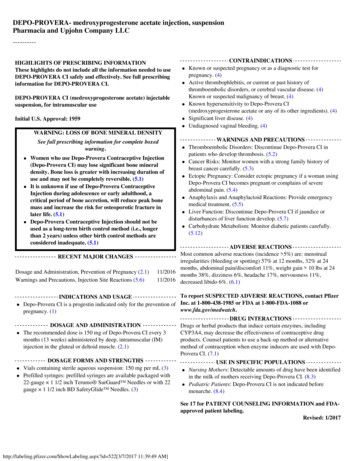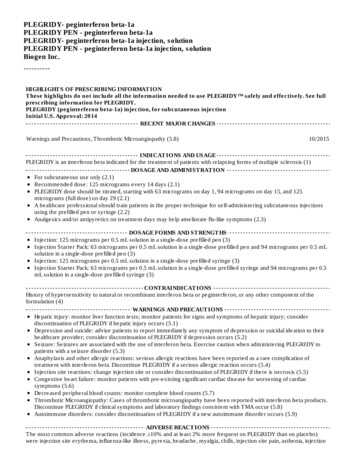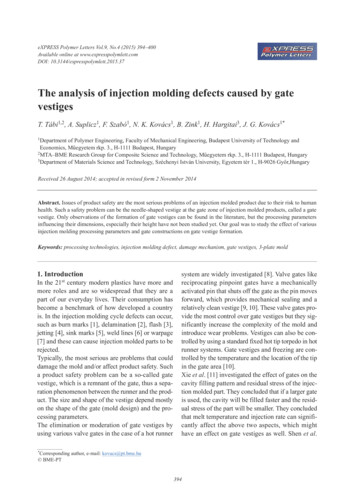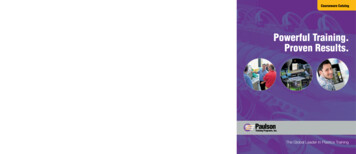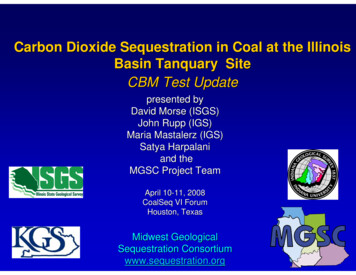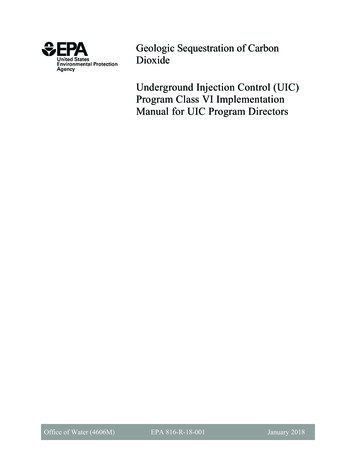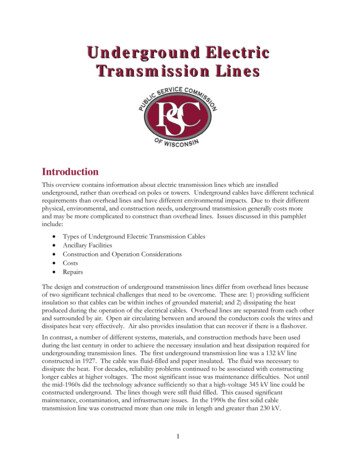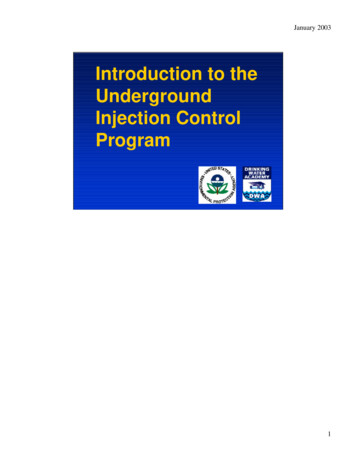
Transcription
January 2003Introduction to theUndergroundInjection ControlProgram1
January 2003Drinking Water Academy Introductory modules– Overview of the Safe Drinking Water Act– Introduction to the EPA’s Source ProtectionPrograms– Introduction to the Underground Injection ControlProgram– Introduction to the Public Water SupplySupervision Program Regulatory modules Technical modules The Drinking Water Academy (DWA) develops and provides training to Federal,State and Tribal drinking water staff to help ensure that they will be adequatelyprepared to implement the provisions of the Safe Drinking Water Act (SDWA). This training course is one of four introductory courses that introduce you to theSafe Drinking Water Act and its major programs:oPublic water system supervision (PWSS);oSource water protection; andoUnderground injection control (UIC). In addition to these introductory courses, the DWA provides training on otherdrinking water topics:oSDWA regulations;oCapacity development;oSanitary surveys;oSDWIS; andoTechnical courses on source water, UIC and public water system issues. The DWA also provides skills training on risk communication and trainingdelivery. For a complete list of the courses the DWA offers, visit our Web site athttp://www.epa /gov/safewater/dwa.html2
January 2003Objectives Describe the foundation of theUnderground Injection Control program Describe the UIC program framework Explain basic geology and injectionwells Explain some of the challenges facingtoday’s UIC program3
January 2003Objective 1 Describe the foundation of theUnderground Injection Control (UIC)program–––––Historical uses of injection wellsRegulatory timelineBasic terminologyEPA’s mandate under SDWAMission of the UIC program4
January 2003Early Injection 1930s:1930s Oil companies began injectingwastes into depleted reservoirs throughconverted oil production wells 1950s:1950s Injection of hazardous chemicaland steel industry wastes began 1960s:1960s Injection practices increase sharplyas the manufacturing of chemicalsboomed When oil is produced, some amount of salt water is also produced along with the oil. Thevolume of associated salt water per barrel of oil ranges from a few ounces to 50 barrels (ormore), and the salinity ranges from less than 10,000 to over 100,000 mg/L total dissolvedsolids (TDS). Disposal of this salt water has posed an environmental problem since oil wasfirst produced in 1859. Prior to 1929, all salt water was discharged into surface water (ditches, creeks, and pits). Inthe 1930s, however, operators discovered that some of the salt water could be re- injected intothe oil zone to maintain reservoir pressure and extend oil production. This was the firstwidespread use of injection wells. Most salt water, however, was still discharged intoditches, creeks, and pits. By the 1950s, landowners began to complain of salt water contamination of ground waterresources. By the mid-1960s, State oil agencies were discovering that salt water dischargeshad contaminated many aquifers by seepage from the surface. In 1967, the Texas Oil andGas Division banned the use of disposal pits for produced salt water, and specified injectionwells as the preferred disposal method. Most States followed soon after, and tens ofthousands of salt water disposal wells were drilled. Most oil companies also owned oil refineries, and by the late 1940s, a few refineries began toinject their liquid waste. Consumer demand for plastics and steel in the 1950s fueled a largeexpansion of those industries, and caused a search for a secure disposal method for the morecomplex wastes that resulted from the new, more-sophisticated technologies. In 1950, therewere only four industrial waste injection wells, and a 1963 inventory listed only 30. By1967, however, there were 110 industrial injection wells operating, and when EPA took aninitial look at the problem in 1974, they found that 322 wells had been drilled in Regions 2through 9, of which 209 were operating.5
January 2003Cause for Concern 1968:1968: Hammermill Paper Company’s leaksuspected to cause contamination five milesaway 1975:1975: Velsicol Chemical Company injectionwell determined to have contaminated anunderground source of drinking water The awareness of the importance of ground water began with the expansion of populationinto the suburbs in the 1960s. The only water supply available in many new suburbs wasground water, but the increase in drilling activity revealed that many aquifers were alreadycontaminated with salt water, due to surface disposal of oil wastes. As a result, groundwater pollution-related lawsuits became common in municipal and state courts, and thefrequency of citizen complaints to state agencies and legislators increased tenfold, asmeasured in Texas, from 1955 to 1970. Responding to constituents' needs and complaints, State legislators began to createpollution-related water and ground water agencies by the mid-1960s, such as the WaterPollution Control Board in Texas. Since 80 percent of industria l injection wells werelocated in Texas, by 1969 the Water Pollution Control Board had developed an injectionwell regulatory program, in addition to its counterpart in the Oil and Gas Division. In addition to the regulatory attention caused by the increase in the use of injectiontechnology for industrial waste disposal, there were two high-profile pollution cases thatattracted national headline attention.oAn industrial waste injection well at Hamermill Paper was improperly sited in anover-pressured injection zone, and injection pressure caused noxious waste to flowuncontrolled out of an abandoned borehole five miles away, destroying the MichiganUnion War Veteran's Memorial Cemetary and polluting Lake Erie.oAnother pollution incident involved a well at a Velsicol Chemical plant in Arkansas,which contaminated a USDW and caused health problems among residents.6
January 2003Regulatory TimelineEarly Stateprogramsto volvedin tFederal UICregulations1980 The sequence of events leading to today’s Underground Injection Control programbegan with State programs. Although as early as the 1930s a few States had regulations conc erning discharges toground water, the regulations were primarily concerned with communication withsurface water or subsurface oil reservoirs. As noted above, the mid-1960s foundState agencies actively involved with ground water pollution issues. Federal authority for ground water and injection wells began in 1972. Althoughground water was not specifically addressed by the Clean Water Act of 1972,Congress required that, in order to qualify for participation in the National PollutantDischarge Elimination System (NPDES) permitting program, States must haveadequate authority to issue permits that control the “disposal of pollutants intowells.” In 1974, with the enactment of the Safe Drinking Water Act, the Federalgovernment took an active role in underground injection control. In response to the1974 Act, EPA promulgated the UIC regulations in 1980. Since 1980, more than150 Federal Register notices have been published regarding UIC, includingadditional regulations, amended regulations, explanations of procedures, andguidance. SDWA was significantly amended two times since 1974: in 1986 and 1996. Inaddition, there were two sets of minor amendments that affected the UIC program in1977 and 1980. The UIC program was EPA’s major tool to protect ground wateruntil the 1986 Amendments. In 1986, Congress created a larger Federal role in theprotection of all ground water from sources other than underground injection.7
January 2003Mission of the UICProgram The UIC program’s mission is to protectunderground sources of drinking waterfrom contamination by regulating theconstruction and operation of injectionwells Injection into the subsurface is one of the primary means of disposing ofliquid wastes in the United States. More than 400,000 injection wells areknown to be in operation, disposing of millions of gallons of hazardous andnonhazardous fluid wastes. EPA implements the UIC mission by working with States, Tribes and localofficials. EPA and States regulate injection wells according to the type of waste thewells inject and how deep the waste is injected. More details on thebreakdown of the wells is provided later in this training.8
January 2003Define Well andUnderground Injection Well: A bored, drilled, or driven shaft, or adug well or dug hole where the depth isgreater than the largest surface dimension; oran improved sinkhole; or a subsurfacedistribution system Underground injection: Subsurfaceemplacement of fluids through a well The Safe Drinking Water Act (SDWA) is the primary statute that governsinjection wells. During deliberations for SDWA in 1974, Congressrecognized the existence of a wide variety of injection wells, and struggled toprovide a statutory definition that might include all possible injection typesand practices. Congress included the “deeper than wide” specification inorder to distinguish injection wells from pits, ponds, and lagoons, whichwere the subject of a different Federal initiative. Thus, injection through a well is defined as the subsurface emplacement offluids through a bored, drilled, or driven well or through a dug well wherethe depth of the dug well is greater than the largest surface dimension; or adug hole whose depth is greater than the largest surface dimension; or animproved sinkhole; or a subsurface distribution system. The definition of a UIC well was updated in December 1999, and the newdefinition makes it clear that many systems not typically thought of at first asa “well” actually meet the definition. The updated definition includessystems such as field tile systems, large capacity septic systems, moundsystems and leach beds.9
January 2003Define Aquifer andUSDW Aquifer: Geologic formation that is capable ofyielding a significant amount of water to a well orspring Underground source of drinking water: An aquiferor portion of an aquifer that– Supplies any public water system or contains a quantity ofground water sufficient to supply a public water system, and– Currently supplies drinking water for human consumption, or– Contains fewer than 10,000 mg/L total dissolved solids andis not an exempted aquifer The definition of an underground source of drinking water (USDW) iscodified in 40 CFR 146.3. The USDW definition ensures that potentialsources of drinking water are protected as stringently as those sourcescurrently used for drinking water. Application of a quality-based groundwater standard rather than a usage-based standard provides for both protectionof the ground water resource and public health. Ground water containingbetween 3,000 and 10,000 mg/L TDS is not suitable for human cons umption,but may be used for livestock, irrigation, and industrial purposes, and can betreated for consumption if alternative water sources are not ava ilable. It is also important to note that the definition of an aquifer includes aformation capable of yielding a significant amount of water to a well. It doesnot mandate that the formation currently be used as a producing watersource (i.e., it does not have to have drinking water wells completed into it). The definition of a transient non-community water system in SDWA’s PublicWater System Supervision (PWSS) program can assist in establishing whethera formation yields enough water to be “significant.” If a formation can yieldwater enough to be regulated under the PWSS program, one would likelyconsider it “significant.” Many private wells produce enough water that theywould meet the PWS production criteria, even though they do not meet thatprogram’s criteria for number of people served.10
January 20031974 SDWA - BasicUIC Concepts Requires EPA to promulgate regulations toprotect drinking water sources fromcontamination through underground injection Defines:– Underground injection– Endangering drinking water sources Designed to be implemented by States SDWA required EPA to determine the need for and to promulgateregulations to protect drinking water sources from contamination throughunderground injection. Underground injection is defined in SDWA as “the subsurface emplacementof fluids by well injection.” This term does not include the undergroundinjection of natural gas for storage.” SDWA also states that undergroundinjection “endangers drinking water sources if such injection may result inthe presence in underground water which supplies or can be reasonablyexpected to supply any public water system of any contaminant, and if thepresence of such contaminant may result in such system’s not complying withany national primary drinking water regulation or may otherwise adverselyaffect the health of persons.” (see SDWA Section 1421(d)(2)). In otherwords, if an aquifer (which meets certain requirements described later in thismodule and is called a “USDW”) that is likely to be used for drinking waterreceives a contaminant by an injection well and the contaminant may cause aprimary drinking water violation, the well is endangering the US DW. Following the model of the National Pollutant Discharge Elimination System(NPDES) program in the Clean Water Act, SDWA designed the UIC programto be implemented by the States. Section 1422 of SDWA provides forprogram delegation to the States, with accompanying grants to fund thecreation and operation of UIC agencies. EPA provides oversight of Stateprimacy agencies, and in States that choose not to assume the program,operates the program itself (i.e., direct implementation).11
January 20031974 SDWA EPA Requirements Mandates that EPA:– Not interfere with oil and gas production– Consider varying geologic, hydrologic, orhistorical conditions– Avoid promulgating regulations that wouldunnecessarily disrupt existing Stateprograms During deliberations for SDWA, there was concern that injection regulation at theFederal level would contradict existing State programs or cause oil and natural gasproduction costs to unnecessarily increase. Further, concern was expressed that theprogram might not address the fact that geology and hydrogeology is highly variableacross the nation. In SDWA, Congress included a provision that EPA not interfere with oil and gasproduction. Section 1421(b)(2) requires that Federal regulations not prescriberequirements that interfere with or impede: 1) the underground injection of brine orother fluids that are brought to the surface in connection with oil or natural gasproduction (natural gas storage was added in 1980); or, 2) any underground injection forthe secondary or tertiary recovery of oil or natural gas unless such requirements foreither of the above are essential to assure that underground sources of drinking waterwill not be endangered by such injection. Section 1422(c) states that a State UICprogram may not have requirements that interfere or impede oil or gas production. Congress also mandated that EPA accommodate existing State programs, and considerlocal geologic conditions. Geologic conditions and oil production practices variedwidely from State to State. Thus, Congress cautioned EPA against a “one-size-fits-all”regulatory scheme, and mandated consideration of local conditions and practices.Section 1421(b)(3)(A) requires that UIC regulations permit or provide consideration ofvarying geologic, hydrological, or historical conditions in different States and indifferent areas within a State. Section 1421(b)(3)(B)(i) requires that to the extentfeasible, EPA must avoid promulgating requirements that would unnecessarily disruptState UIC programs already in effect and being enforced in a sub stantial number ofStates.12
January 2003SDWA Changes From1974 To Present Addition of section1425 applicable tooil and gas relatedwells in 1980 Additionalrequirements forhazardous wasteUIC wells in 1986 Expanded groundwater protectionfocus in 1986 SDWA was amended in 1977, 1979, 1980 and again in 1986. Additionally, Congress reauthorized and amended SDWA in 1996. Many of the changes to the Act over time werefocused on procedures to be followed by EPA and/or State UIC programs. Some verysignificant impacts were felt in the program, however, when Section 1425 was added in1980. Section 1425 allows a State to obtain primacy from EPA for oil and gas related injectionwells, without being required to adopt the complete set of applicable Federal UICregulations. The State must be able to demonstrate that its existing regulatory programis protecting USDWs without the State regulations being as stringent as Federal rules. The 1986 amendments included the addition of a new set of more stringentrequirements for deep injection wells that dispose of hazardous wastes. Theserequirements are discussed later. Amendments made in that year also expanded EPA’sresponsibility for ground water protection and stewardship. In response to the statutoryamendments, EPA developed the Ground Water Protection Program. This program doesnot have regulations, but conducts outreach and assists States in designing andimplementing wellhead protection (WHP) programs. The WHP programs offer a costeffective means of protecting ground water, and provide an excellent opportunity toeducate communities on the UIC Program’s priorities. Congress required EPA to assess the UIC program’s progress since 1974 as part of the1986 amendments as well. One focal point was to assess the impact of shallow injectionwells. EPA responded with the 1987 Report to Congress, which is often referenced inEPA UIC reports and other documents.13
January 2003Objective 2 Describe the UIC program framework– UIC program terminology– Structure of the UIC program– Other Federal statutes affecting UIC14
January 2003UIC Terminology Primacy Primacy State or Tribe Direct Implementation State or Tribe Code of Federal Regulations Primacy - Primary enforcement authority. EPA may grant States and Tribesprimacy for all or parts of the UIC program. For example, a State may onlyhave primacy for certain types (or classes) of injection wells. If a State doesnot have primacy, the EPA Region directly implements the program andretains primary enforcement authority. Primacy State or Tribe- A State or Tribe with primary enforcementauthority for one or more types (classes) of injection well. Direct Implementation (DI) State or Tribe - A State or Tribe that does nothave primary enforcement authority and in which the EPA Region directlyimplements the UIC program. Code of Federal Regulations (CFR) - Environmental regulations arecodified in Title 40 of the CFR. The Federal UIC regulations are found at40 CFR Parts 144 - 148.15
January 2003Structure of the Program:Primacy Requirements Must promulgate requirements that areat least as stringent as EPA’s:– Prohibit injection unless authorized by ruleor permit– Prevent underground injection thatendangers drinking water sources– Implement requirements for inspection,monitoring, recordkeeping, and reporting May be more stringent than EPA’sregulations When a State or Tribe has primacy for the UIC program, it means that theState or Tribe has the lead responsibility for administering and enforcing theprogram and must have the staff and funding to run the program. Upon receiptof primacy, a State must implement all the requirements specified in the EPA- State agreement, and track the program’s progress to demonstrate that theagreement is being appropriately followed. Congress defined the requirements that must be met to qualify for primacy,methods of application for primacy, and standards of operation necessary toretain primacy. Section 1422 of SDWA lists these requirements and EPAexpanded on these requirements in regulations in 40 CFR Part 145.oA State or Tribe must adopt statutes and regulations that are at least asstringent as the Federal regulations and receive program approval fromthe EPA Administrator.oHowever, States or Tribes can obtain primacy for strictly oil and gasrelated wells (under Section 1425 of SDWA) if the State program isdemonstrated to be effective in protecting USDWs even if the Stateregulations do not match all the Federal regulations. Congress authorized grants to fund primacy States’ UIC programs. The grantallocation is tied to injection well usage in each primacy State. States withoutprimacy, where EPA administers the UIC program, do not receive thisfunding. Congress provided that States and Tribes may adopt regulations that are morestringent than Federal rules. Numerous States have adopted requirementsthat exceed the Federal standards.16
January 2003Structure of the Program:UIC Primacy Delegation The map above illustrates the status of program delegation natio nally as ofJune 2001. EPA has delegated primacy for all well classes to 34 States; itshares responsibility in six States; and implements a program fo r all wellclasses in ten States. The Agency has also delegated primary enforcementresponsibility to three territories. Native American Tribes follow the same rules as States to obtain primacy, ifthey are a “Federally Recognized Tribe” and have been designated for“treatment similar to a State.” To date, the UIC program in all NativeAmerican lands is implemented by EPA. The primacy application process is lengthy, and requires a great deal ofcommunication between the EPA Region and the State or Tribe submittingthe application. Section 1422(a) requires EPA to make a list of States that need UICprograms. That list is in 40 CFR Part 147. This part of the CFR can assistyou in determining the status of a particular UIC program in a givengeographic area. However, for the latest information, contact the EPARegional Office UIC staff.17
January 2003Structure of the Program:UIC Regulations 40 CFR Part 35 - State and TribalFinancial Assistance 40 CFR Part 124 - Public ParticipationRequirements 40 CFR Part 144 - Permitting andProgram Requirements 40 CFR Part 145 - Requirements andProcedures for State Program Approval The UIC regulations are found in 40 CFR Parts 144, 145, 146, 147, and 148.Parts 35 and 124 include procedural requirements for all EPA Programs.Part 124, Public Participation Requirements, is significant as it describesthe requirements for public notification of pending permits and publiccomment periods, as well as other public participation requirements. Part 144, Underground Injection Control Program, describes the generalrequirements of the UIC Program, authorizes certain types of wells by rule,and defines procedures for applying for a UIC permit or submittinginventory information. This section also describes conditions applicable toall UIC permits and establishes minimum permit conditions, such asconstruction, operation, testing, and monitoring requirements. Subpart Festablishes procedures for ensuring financial responsibility for plugging andabandoning (i.e., closing) wells. Part 145, State UIC Program Requirements, describes the requirementsthat State programs applying for primacy must meet and the method forobtaining program approval, such as the required elements of a Stateprogram submission. It also describes EPA’s procedures and criteria forreviewing State applications for primacy, including procedures by whichEPA can approve, review, or withdraw primacy.18
January 2003Structure of the Program:UIC Regulations 40 CFR Part 146 - UIC Criteria andStandards 40 CFR Part 147 - State UIC Programs 40 CFR Part 148 - Hazardous WasteInjection Restrictions Part 146, UIC Program: Criteria and Standards, contains the technical criteriaand standards for the various classes of underground injection wells. A subpartdevoted to each UIC well class describes construction, operating, monitoring, andreporting requirements, along with information to be considered in determiningwhether to grant a permit. Other standards and requirements specific to well typesare included in this portion of the CFR. Part 147, State UIC Programs describes the provisions of the State primacyprograms. Each subpart of Part 147 is devoted to an individual State; it outlineswhich aspects of the UIC program are overseen by EPA, and which are delegatedto the State. It incorporates by reference all pertinent State rules and regulations soas to allow EPA to take direct enforcement action in primacy States. Part 148, Hazardous Waste Injection Restrictions, identifies hazardous wastesthat are restricted from disposal into deep hazardous waste injection wells. Therequirements of this Part will be discussed in the well class-specific discussion laterin this course. Briefly, this Part outlines the standards and procedures by whichClass I hazardous waste facility operators may petition to dispose of restrictedhazardous wastes. Part 148 requires operators of Class I hazardous waste injectionwells to demonstrate with reasonable certainty that the hazardous components oftheir wastewaters will not migrate from the authorized injection zone.19
January 2003Structure of the Program:Authorization by Rule andPermitting Some wells may be authorized by rule;permit not required if comply with basicrequirements Some well owners or operators must applyfor permits to drill and to operate All wells must submit inventory data All wells are subject to non-endangermentstandard When a well is authorized by rule, it means that the owner/operator doesnot have to apply to EPA or the State for a permit as long as he complieswith the requirements of the rule. Some UIC well types require a permit todrill before the well may be installed, and a permit to operate before the wellmay be used. The owner or operator must apply for a permit from EPA orthe primacy State. The permit application requirements, as well asconditions imposed in a permit, vary based on the type of well, materialinjected, geology of the area and other factors. Owners or operators of all UIC wells, whether the well is subject topermitting or is authorized by rule, are required to submit basic inventoryinformation to the appropriate regulatory agency. Additionally, all wells areprohibited from endangering USDWs, known as the “non-endangermentstandard”. (See page 11 for definition.)20
January 2003Structure of the Program:Inspections EPA is authorized to inspect any facilitysubject to the UIC program Types of inspections vary, based onstatus of wells and facility EPA UIC inspector training available All UIC wells are subject to inspections from State or Federal UIC programpersonnel. The frequency of inspections, and the level of scrutiny of theinspection vary with the well status, type of well, type of waste injected,history of compliance, and other factors. The primary goal of a UIC inspection is to assemble information that can beused to determine compliance with permit conditions and/or other regulatoryrequirements. Inspections vary in focus from pre-operations and construction,to routine compliance and operation, to well testing or well closure. The EPA UIC Inspector Training Course offers more detail on inspections,and all personnel responsible for evaluating UIC compliance areencouraged to take this course. Through that course, you will learn about thevarious inspections conducted, what transpires during the inspections, properdocumentation of each inspection type, and how to respond to variousnoncompliance situations that may be encountered during inspections.21
January 2003Structure of the Program:Enforcement Primacy agencies and Regional DIprograms Office of Enforcement and ComplianceAssurance– Office of Regulatory Enforcement– Office of Compliance State primacy agencies and Regional DI programs typically take the lead onenforcement cases in primacy States and DI States, respectively. The Office of Regulatory Enforcement (ORE) serves as the focal point for allenforcement actions of the UIC program. ORE’s Water Enforcement Division (WED)works with technical staff (primarily in the Regions) to develop enforcement casesagainst facilities meriting enforcement action. This office also develops nationalenforcement policy and guidance. The Office of Compliance (OC) does not pursue actual enforcement activities, butdevelops and supports initiatives to assist well operators and owners in understandingrequirements and achieving compliance. This may take the form of training, databasedevelopment and maintenance, outreach to the regulated community, the development of“Sector Notebooks” (primers describing industries such as automotive, oil and gas,railroads), or other activities. Each State has its own enforcement procedure, which must meet certain Federalrequirements and which is described and approved through the primacy process.22
January 2003Structure of the Program:Enforcement Enforcement tools available include:– Informal enforcement actions– Formal enforcement actions (section 1423)– Others (emergency authority) The most successful State efforts to achieve compliance are often preventive efforts and informalenforcement actions. Preventive efforts are aimed at notifying and educating an operator aboutrequirements, and can result in avoiding critical problems. Examples of preventive efforts includeguidance documents, reminder letters, on-site meetings and technical assistance. Informal actions are generally taken for minor violations such as failure submit minor data points frommonitoring. Examples of informal actions include notices of violation; on-site meetings; and technicalassistance. States and EPA generally reserve their strongest enforcement tools for owners and operators who havenot been responsive to enforcement actions, facilities whose vio lations pose significant public healththreats, or facilities with a history of noncompliance. These formal actions include administrativeorders, issued at the agency level. An administrat
addition, there were two sets of minor amendments that affected the UIC program in 1977 and 1980. The UIC program was EPA's major tool to protect ground water until the 1986 Amendments. In 1986, Congress created a larger Federal role in the protection of all ground water from sources other than underground injection. 7




